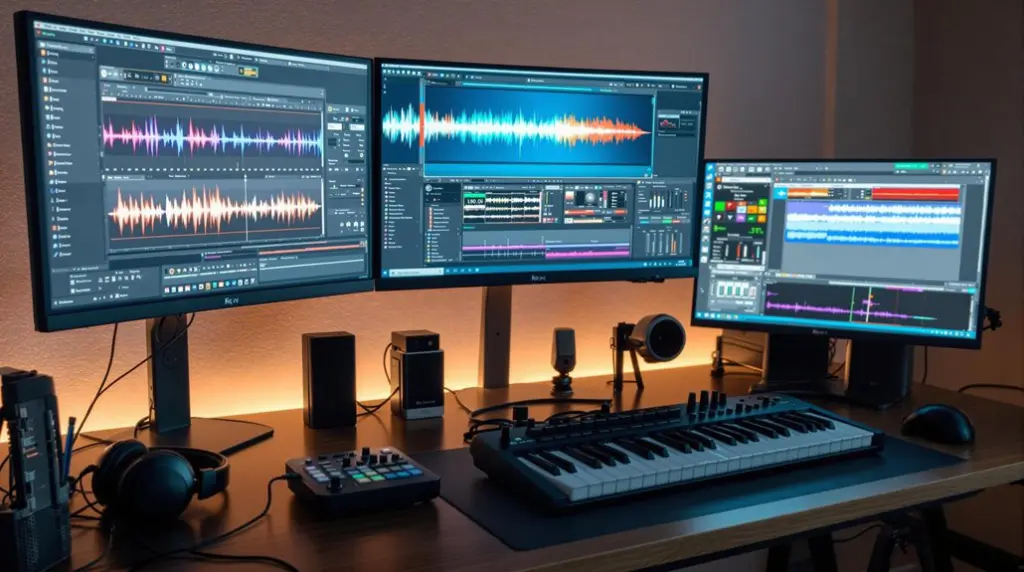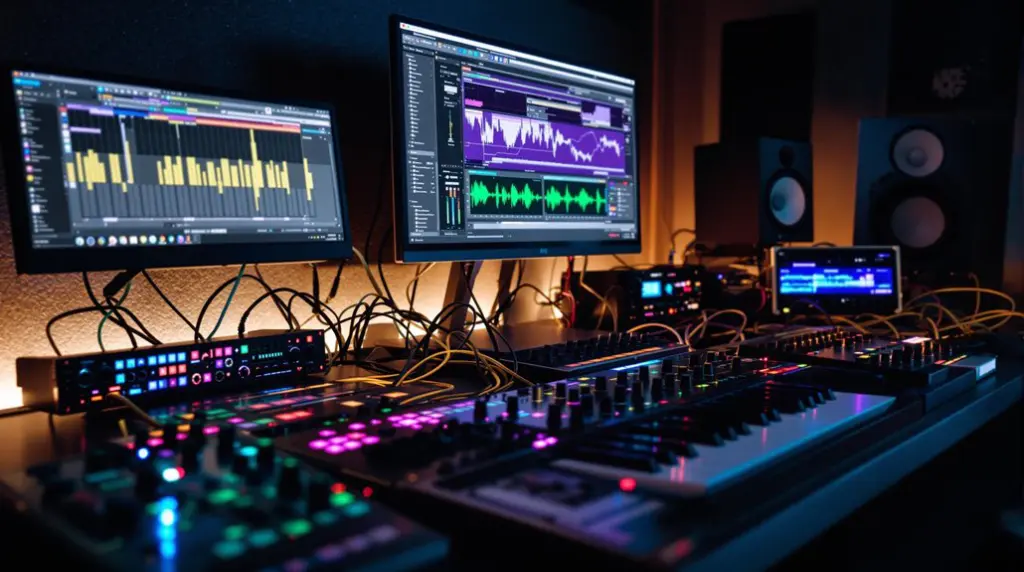The top five EQ plugins for pro-level audio mixing include Sonible Smart:EQ 4, TDR Nova, Carve EQ, Morph EQ, and Pro-Q 3. Sonible Smart:EQ 4 utilizes AI for tailored equalization. TDR Nova offers dynamic EQ across four bands for enhanced control. Carve EQ features mid/side processing and EQ matching capabilities. Morph EQ allows for dynamic filter adjustments with real-time adaptations. Pro-Q 3 stands out with up to 24 EQ bands and an integrated spectrum analyzer for precise frequency manipulation. Each of these plugins offers unique functionalities, enhancing both corrective mixing and creative sound design. Further exploration reveals additional insights into their applications.
Key Takeaways
- Sonible Smart:EQ 4 employs AI for tailored EQ settings, enhancing audio material without overwhelming the user.
- TDR Nova features four bands of dynamic EQ, combining corrective and creative mixing for versatile sound design.
- Carve EQ allows mid/side processing and EQ matching, providing precise control over frequency adjustments for better mix clarity.
- Morph EQ utilizes dynamic morphing filters and adaptive Q, enabling real-time adjustments to fit changing audio signals effectively.
- Pro-Q 3 offers up to 24 EQ bands and dynamic processing, ensuring detailed and transparent adjustments while maintaining mix integrity.
Sonible Smart:EQ 4
Sonible Smart:EQ 4 represents a considerable advancement in audio mixing technology, employing artificial intelligence to enhance the equalization process. This plugin integrates a dynamic EQ mode, allowing users to execute precise EQ adjustments while effectively managing problematic frequencies.
The unique Smart analysis feature tailors EQ settings to the specific audio material, thereby optimizing frequency management without sacrificing the mix’s overall character. Additionally, the user-friendly interface consolidates all EQ controls within a single window, considerably improving workflow efficiency for producers.
Its compatibility with various digital audio workstations (DAWs) further underscores its versatility, making Smart:EQ 4 an indispensable tool for professionals seeking to streamline their mixing process through innovative AI technology. Furthermore, its ability to manage resonances effectively aligns with the capabilities of dynamic resonance suppressors found in popular EQ plugins like Oeksound Soothe2.
TDR Nova
Building on the advancements in intelligent equalization exemplified by Sonible Smart:EQ 4, TDR Nova offers a distinct approach as a versatile dynamic equalizer that caters to both corrective and creative mixing needs.
This free plugin features four bands of equalization with dynamic capabilities, making it suitable for a variety of mixing tasks, from corrective adjustments to intricate tonal shaping. Its user-friendly interface allows for intuitive navigation, appealing to both beginners and seasoned professionals alike.
Importantly, TDR Nova incorporates parallel processing, facilitating seamless blending of processed and original signals. This feature enhances workflow efficiency and provides greater control over the mixing process, ultimately contributing to more refined sonic results while managing potential harshness in high frequencies. Additionally, the plugin’s capabilities are further enhanced by its dynamic control features, which maintain the integrity of the final mix while allowing for expressive sound design.
Carve EQ
Carve EQ stands out as a powerful tool in the audio mixing environment, designed to enhance user experience through its intuitive and adjustable graphical user interface (GUI). This user-friendly plugin accommodates various screen sizes, making it accessible for producers at all skill levels.
Carve EQ features mid/side processing, allowing independent frequency adjustments to left and right channels, thereby improving stereo imaging. Its EQ matching feature facilitates achieving desired tonal characteristics by comparing the source audio to a target EQ curve.
Additionally, the parallel EQ function enables blending processed and unprocessed signals, offering versatile mixing options. The graphical interface allows for visual manipulation of EQ curves, providing precise control over frequency adjustments and enriching the overall mixing experience. Investing in high-quality analog compressors and equalizers can further enhance the sound by providing unique coloration and dynamic control to audio.
Morph EQ
Morph EQ represents a significant advancement in equalization technology, offering a dynamic approach to audio processing through its innovative morphing filter movements.
This plugin features an adaptive Q, allowing for precise frequency control by adjusting filter bandwidth in real-time based on the input signal. The filter solo function enhances targeted adjustments, enabling users to isolate specific frequencies without impacting the overall mix.
With custom morph points, users can implement dynamic EQ changes that evolve throughout a track, enriching sound depth and movement. The graphical interface supports visual manipulation of EQ curves, facilitating intuitive adjustments and enhancing the user experience. Additionally, Morph EQ’s capabilities align with dynamic EQ strategies, allowing for surgical precision in audio shaping while managing frequency fluctuations effectively.
Pro-Q 3
FabFilter Pro-Q 3 stands as a benchmark in the field of audio equalization, distinguished by its extensive feature set that caters to both mixing and mastering applications.
Offering up to 24 EQ bands, it provides unparalleled flexibility for intricate frequency adjustments in professional audio. The dynamic EQ mode allows for frequency boosts or cuts based on signal thresholds, enhancing responsiveness during mixing.
Pro-Q 3 supports mid/side processing, enabling independent adjustments to stereo channels, which is essential for achieving spatial control. Its integrated real-time spectrum analyzer aids in visualizing frequency content, thereby identifying problematic areas efficiently.
Additionally, the linear phase mode guarantees transparent adjustments, making Pro-Q 3 an indispensable tool for mastering without introducing phase issues. Moreover, its ability to make minor EQ adjustments ensures tonal balance, which is crucial for achieving a polished sound.
Frequently Asked Questions
What Is the Best EQ for Mixing?
Determining the best equalizer for mixing hinges on factors such as analog emulation, digital precision, parametric control, and dynamic EQ capabilities. Effective surgical cuts and shelving boosts across frequency ranges enhance workflow efficiency, ensuring peak audio quality.
What Is the Best Mastering EQ Plugin?
In mastering, the best EQ plugin enhances audio dynamics through precise equalization strategies. Consider factors like frequency response, workflow integration, and sound design capabilities when evaluating plugin comparisons to optimize your studio setup and mastering techniques.
What Is the Most Transparent Mastering EQ?
The most transparent mastering EQ emphasizes audio clarity through advanced EQ settings and frequency response, facilitating effective mixing strategies. Plugin comparison reveals options like Dangerous Music BAX EQ and FabFilter Pro-Q 3, renowned for their tonal balance and versatility.
What Plugins Do You Use for Mixing?
For mixing, I utilize a combination of vintage plugins and digital plugins, emphasizing analog emulation for warmth, surgical EQ for precision, dynamic EQ for adaptability, and linear phase options for spectral shaping, enhancing overall workflow efficiency.
Conclusion
To conclude, the selection of equalization plugins greatly influences the quality of audio mixing. Sonible Smart:EQ 4 offers intelligent processing, while TDR Nova provides dynamic capabilities for precision. Carve EQ excels in its intuitive interface, whereas Morph EQ introduces innovative morphing features for sound design. Pro-Q 3 remains a staple for its all-encompassing functionality and versatility. Each plugin presents unique advantages, catering to the diverse needs of audio professionals seeking to achieve high standards in their work.




